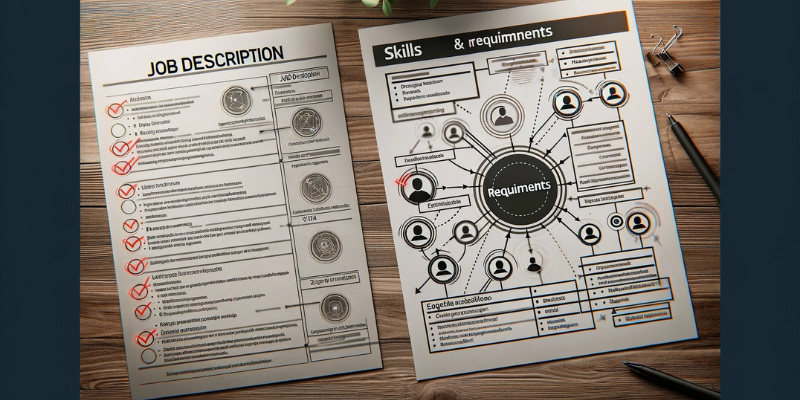Table of Contents
Introduction
In today's competitive job market, standing out from the crowd is more crucial than ever. One key way to differentiate yourself is by tailoring your CV to each job application. This process, however, can be daunting and is often shrouded in confusion. In this comprehensive guide, we aim to demystify the process and provide you with a step-by-step approach to customizing your CV for any job application.
Why is tailoring your CV so important? Each job and employer is unique, and your CV should reflect that. A tailored CV not only demonstrates that you're a good fit for the role but also shows your dedication and attention to detail – qualities that every employer values. By aligning your CV closely with the job requirements, you're more likely to catch the eye of hiring managers and make it past automated screening systems.
Throughout this guide, we'll cover everything from understanding the basics of a CV, analyzing job descriptions, and step-by-step instructions for customization. By the end, you'll be equipped with the tools and knowledge to tailor your CV effectively, enhancing your chances of landing your dream job.
Key Takeaway: Tailoring your CV for each job application is a crucial step in the job search process, highlighting your suitability and dedication to the role.
Understanding the Basics of a CV

A Curriculum Vitae (CV) is more than just a summary of your experiences and qualifications. It's a personal marketing tool, designed to showcase your skills, achievements, and potential to prospective employers. Unlike a resume, which is typically concise and focused on recent experiences, a CV is more detailed and comprehensive. It covers your entire career, including academic achievements, research, publications, awards, and more.
Key Components of a CV:
-
Personal Information: Name, contact details, and sometimes a professional photo.
-
Education: Academic history, degrees, certifications, and relevant coursework.
-
Work Experience: A list of previous roles, responsibilities, and achievements.
-
Skills: Both hard and soft skills relevant to your career field.
-
Additional Sections: Publications, awards, volunteering, languages, and other relevant activities.
Understanding these components is crucial for crafting a CV that accurately reflects your professional journey. It’s also important to distinguish between a CV and a resume. While a resume is usually tailored to a specific job, highlighting relevant experiences and skills, a CV is a comprehensive record of your entire career. However, even with a CV, tailoring is key to highlight the most relevant aspects of your career in relation to the job you're applying for.
Remember: A well-crafted CV is your ticket to an interview. It should present your professional story in a way that aligns with your career goals and the requirements of the roles you're applying for.
Actionable Tip: Regularly update your CV with new skills, experiences, and achievements, even when you're not actively job searching. This makes tailoring your CV for specific applications quicker and more efficient.
3Sixty Careers offers a CV builder tool that includes all elements needed for crafting a job winning CV. Create your free accont by click here
Analyzing Job Descriptions

Before you begin tailoring your CV, it's essential to analyze the job description of the role you're applying for. Job descriptions provide a wealth of information and serve as a guide to what the employer is looking for in an ideal candidate.
How to Analyze Job Descriptions:
-
Identify Key Skills and Requirements: Look for repeated phrases or specific skills that are emphasized. These are likely the primary competencies the employer is seeking.
-
Understand the Company Culture: Pay attention to the language used in the job description. It can give clues about the company culture and values.
-
Note Any Specific Instructions: Some job descriptions include specific instructions, such as a desired format for your CV or additional documents to include.
By thoroughly understanding the job description, you can identify which parts of your professional history are most relevant and should be emphasized in your tailored CV.
Pro Tip: Create a list of keywords and phrases from the job description. Use these throughout your CV where relevant, as this can help your application pass through Applicant Tracking Systems (ATS) and catch the attention of recruiters.
Step-by-Step Guide to Tailoring Your CV
Tailoring your CV for each job application is not about rewriting your entire CV each time; it's about making strategic edits to highlight the most relevant aspects of your experience. Here's how to do it effectively:
-
Start with a Strong Base CV:
-
Begin by creating a comprehensive CV that includes all your experiences, skills, and achievements.
-
This base CV serves as a foundation, which you can then modify for each job application.
-
-
Research the Company:
-
Understanding the company's culture, values, and mission can help you align your CV accordingly.
-
Visit their website, read recent news about them, and use this information to tailor your CV to fit their brand and ethos.
-
-
Align Your CV with the Job Description:
-
Compare your base CV to the job description.
-
Emphasize experiences and skills that match the key requirements of the job.
-
Use similar language and keywords found in the job posting to increase the likelihood of passing through ATS.
-
-
Highlight Relevant Experiences and Skills:
-
Prioritize your most relevant job experiences and skills at the top of their respective sections.
-
For each job role listed, include bullet points that showcase achievements and responsibilities that align with the new job's requirements.
-
-
Optimize the Layout and Format:
-
Choose a CV format that best showcases your relevant experiences. Chronological, functional, and combination formats each have their advantages.
-
Ensure your CV is visually appealing, with a clean layout, professional font, and a balance of text and white space.
-
Example of Tailored Experience Section:
Original Experience:
-
Sales Assistant, ABC Retail, 2018-2020
-
Responsibilities: Managed inventory, provided customer service, assisted with sales processing.
Tailored for a Marketing Role:
-
Sales Assistant, ABC Retail, 2018-2020
-
Key Achievements:
-
Developed an in-store promotional campaign that increased foot traffic by 20%.
-
Leveraged social media platforms to enhance customer engagement and sales.
-
Key Takeaway: Tailoring your CV involves emphasizing the parts of your experience that are most relevant to the job you're applying for. It's about showing employers that you're not just qualified, but you're the right fit for their specific needs.
Writing Compelling CV Content
The content of your CV should not just list your experiences; it should highlight your achievements and impact. Here's how to write content that stands out:
-
Use Action Verbs: Begin bullet points with action verbs like "developed," "led," "achieved," to make your experiences sound more dynamic and impactful.
-
Quantify Achievements: Whenever possible, use numbers to quantify your achievements. For example, "Increased sales by 30%" is more impactful than "Increased sales."
-
Tailor Your Language: Use industry-specific jargon and keywords from the job description to show that you understand the field and are a good fit.
Example of a Bullet Point Before and After:
Before:
-
Managed a team.
After:
-
Led a team of 10, enhancing productivity by 25% through strategic leadership and skill development initiatives.
Key Takeaway: Your CV's content should not only describe what you have done but also demonstrate the value you brought to your roles. This approach will make your application more compelling to potential employers.
Customizing the Education Section
The education section of your CV is not just a list of degrees; it can be a powerful tool to show your suitability for the job, especially if your work experience is limited.
-
Prioritize Relevant Education: If you have multiple degrees or certifications, prioritize those most relevant to the job.
-
Include Relevant Courses and Projects: Mention specific courses or projects that are directly relevant to the job. This shows your targeted knowledge in the field.
-
Highlight Academic Achievements: If applicable, include honors, scholarships, or academic awards that demonstrate your expertise and dedication.
Example:
Original Education Section:
-
B.A. in Psychology, XYZ University, 2015-2019
Tailored for a Human Resources Role:
-
B.A. in Psychology (Specialization in Organizational Behavior), XYZ University, 2015-2019
-
Relevant Coursework: 'Workplace Motivation and Leadership,' 'Conflict Resolution,' 'Team Dynamics.'
-
Achievements: Dean’s List 2017-2019, President of the Psychology Students’ Association.
Key Takeaway: Tailor the education section to showcase how your academic background makes you a strong candidate for the specific role, especially through relevant coursework and achievements.
Incorporating Soft Skills and Certifications
Soft skills are increasingly valued in the workplace, and certifications can provide an edge in technical fields. Here's how to effectively include them:
-
Identify Relevant Soft Skills: Match your soft skills with those sought in the job description. Skills like communication, teamwork, problem-solving, and adaptability are universally valued.
-
Showcase Certifications: Include any certifications that are relevant to the job. This demonstrates your commitment to continuous learning and expertise in specific areas.
Example:
Original Skills Section:
-
Skills: Team Leadership, Project Management, Communication, Microsoft Office.
Tailored for a Data Analyst Role:
-
Skills: Advanced Data Analysis, Statistical Methods, Communication, Problem-Solving.
-
Certifications: Certified Data Analyst – DataCamp, Advanced Excel Training.
Key Takeaway: Effectively showcasing your soft skills and relevant certifications can significantly enhance your CV, indicating both your personal qualities and technical proficiencies.
The Role of Keywords in Your CV

Keywords play a crucial role in your CV, especially in navigating Applicant Tracking Systems (ATS) that many employers use.
-
Understand ATS: ATS systems scan CVs for specific keywords related to the job. If your CV lacks these, it might not be seen by human eyes.
-
Use Job Description Keywords: Incorporate keywords from the job description naturally throughout your CV. This includes skills, tools, technologies, and job-specific terms.
-
Balance is Key: Avoid keyword stuffing. Use keywords naturally and in context to maintain readability and professionalism.
Example:
Original Skills Section:
-
Skills: Team Leadership, Efficient, Good Communication, Proficient in Microsoft Office.
Tailored for an IT Manager Role:
-
Skills: Team Leadership in IT Environments, Efficient Project Management, Clear Communication, Proficient in Microsoft Office, Familiar with Agile and Scrum methodologies.
Key Takeaway: Strategically use keywords from the job description in your CV to improve your chances of passing through ATS systems while keeping the content natural and readable.
Proofreading and Final Touches
The final step in tailoring your CV is proofreading and adding those finishing touches that can make a significant difference.
-
Attention to Detail: Carefully proofread your CV for any spelling or grammatical errors. These mistakes can detract from your professionalism and attention to detail.
-
Consistent Formatting: Ensure that your CV has consistent formatting throughout. This includes font sizes, headings, and bullet point styles.
-
Get Feedback: Have someone else review your CV. Fresh eyes can catch errors you might have missed and provide valuable feedback on how your CV comes across.
Checklist for Final Review:
-
Spelling and grammar checked.
-
Consistent formatting in font, headings, and bullet points.
-
Contact information is accurate and up to date.
-
Relevant keywords from the job description included.
-
Each section of the CV aligns with the job requirements.
Pro Tip: Consider reading your CV out loud. This can help you catch awkward phrasing and improve the overall flow of your content.
Key Takeaway: A well-proofread CV with consistent formatting and a professional presentation can leave a lasting positive impression on potential employers.
Common Mistakes to Avoid When Tailoring Your CV
Even with the best intentions, there are common pitfalls to avoid when tailoring your CV:
-
Overloading With Irrelevant Information: Avoid cluttering your CV with experiences or skills that are not relevant to the job. Quality over quantity is key.
-
Being Too Vague or Generic: Tailor your CV to be specific to the role and company. Generic CVs are easy to spot and less likely to make an impact.
-
Failing to Demonstrate Impact: Rather than just listing responsibilities, focus on the impact and achievements in your roles.
Example of a Common Mistake:
Before:
-
Managed a team and increased efficiency.
After Tailoring (Improved):
-
Led a team of 12, implementing new project management strategies that boosted efficiency by 35%.
Key Takeaway: Avoiding these common mistakes can greatly increase the effectiveness of your CV in landing you an interview.
Advanced Tips for Seasoned Professionals
For seasoned professionals, tailoring a CV can involve unique considerations to effectively showcase extensive experience and expertise:
-
Focus on Leadership and Strategic Impact:
-
Highlight roles and projects where you drove strategic decisions or led significant initiatives.
-
Example: "Led a company-wide digital transformation initiative, resulting in a 40% increase in process efficiency."
-
-
Showcase Industry Expertise:
-
Include industry-specific achievements and contributions.
-
Example: "Published 10+ articles in top industry journals on topics related to cybersecurity trends."
-
-
Prioritize Recent, Relevant Experience:
-
While your career may be long and distinguished, focus on the most recent and relevant experiences for the job you’re applying for.
-
Consider a 'Selected Career Highlights' section for older, significant roles.
-
-
Demonstrate Continued Learning and Adaptability:
-
Show that you’ve kept up with industry changes through courses, certifications, or involvement in industry forums.
-
Example: "Certified Agile Project Manager, continuously engaged in professional development workshops."
-
-
Tailor Your Executive Summary:
-
Your executive summary should clearly articulate your unique value proposition and career goals.
-
Example: "Seasoned IT Executive with a proven track record in leading cross-functional teams to deliver innovative technology solutions."
-
Key Takeaway: For seasoned professionals, a CV should not only reflect a wealth of experience but also demonstrate strategic impact, industry expertise, and a commitment to ongoing professional development.
Additional Resources and Tools
To further aid in tailoring your CV, numerous resources and tools are available:
-
CV Tailoring Tools:
-
Platforms like 3Sixty Careers offer templates and tools to help customize your CV for different applications.
-
-
Professional CV Writing Services:
-
Consider hiring a professional CV writer, especially if you’re targeting executive roles or highly specialized fields.
-
-
Online Courses and Workshops:
-
Websites like LinkedIn Learning and Coursera offer courses on CV writing and career development.
-
Key Takeaway: Utilizing available tools and resources can significantly streamline the process of tailoring your CV and ensure that it stands out in a competitive job market.
Conclusion
Tailoring your CV for each job application is a vital step in your job search strategy. It requires an understanding of your own experiences and skills, as well as a deep dive into what potential employers are looking for. By following the steps and tips outlined in this guide, you can craft a CV that not only showcases your qualifications but also demonstrates your fit for the specific role and organization you're targeting.
Remember, your CV is often the first impression you make on a potential employer. Make it count by taking the time to tailor it thoughtfully and strategically.
Final Thought: The effort you put into tailoring your CV can be the deciding factor in landing your dream job. It’s an investment in your professional future.
FAQs
Q1: How often should I update my CV?
-
A: It's good practice to update your CV regularly, at least every six months, or whenever you gain new skills or experiences.
Q2: Should I include hobbies and interests in my CV?
-
A: Only include hobbies and interests if they are relevant to the job or demonstrate transferable skills.
Q3: How long should my CV be?
-
A: For most professionals, a two-page CV is ideal. However, for seasoned professionals with extensive experience, a longer CV may be necessary.








